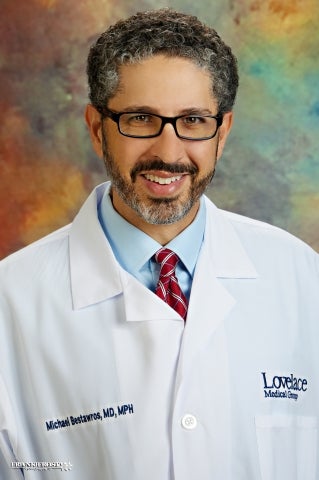Cardiac arrhythmia treatments
The Heart Hospital of New Mexico at Lovelace Medical Center offers treatments for patients with irregular heartbeats (arrhythmia). Our heart rhythm specialists are committed to your complete wellness, which is why we provide care for various types of arrhythmia. Equipped with advanced diagnostic technology, our heart rhythm clinic offers a variety of arrhythmia management services. Our treatments include device implantation, ablation therapy, 3D imaging, and access to leading clinical trials. No matter your needs or condition, our cardiac care team will ensure you receive the best course of treatment possible.
What is arrhythmia
Arrhythmia is a term that describes an irregular heartbeat rhythm. Problems with any part of the heart’s electrical system can result in arrhythmia. During arrhythmia, the heart may beat too fast, too slow, or with an irregular rhythm that feels as though it “skips a beat.”
There are many types of arrhythmia, including:
- Atrial fibrillation (AFib)
- Bradycardia
- Heart block
- Palpitations
- Supraventricular Tachycardia (SVT)
The type of arrhythmia you have will determine your course of treatment.
Atrial fibrillation
Atrial fibrillation (AFib) is the most common serious abnormal heart rhythm and, as of 2020, affects more than 33 million people worldwide. AFib is an abnormal heart rhythm characterized by the rapid and irregular beating of the atrial (upper) chambers of the heart. It often begins as short periods of abnormal beating, which become longer or continuous over time.
Often, arrhythmia episodes have no symptoms, though there may occasionally be heart palpitations, fainting, lightheadedness, shortness of breath, or chest pain. AFib is associated with an increased risk of heart failure, dementia, and stroke.
Atrial fibrillation risk factors include:
- Chronic obstructive pulmonary disease (COPD)
- Cardiomyopathy
- Congenital heart disease
- Coronary artery disease
- Diabetes mellitus
- Excessive alcohol intake
- Heart failure
- High blood pressure
- Obesity
- Sleep apnea
- Tobacco smoking
- Valvular heart disease
Healthy lifestyle changes, such as weight loss in people with obesity, increased physical activity, and drinking less alcohol, can lower the risk for atrial fibrillation and reduce its burden if it occurs.
Healthcare professionals may suspect AFib by feeling the pulse and confirm the diagnosis by interpreting an electrocardiogram (ECG). A typical ECG in AFib shows no P waves and an irregular ventricular rate.
AFib is often treated with medications to slow the heart rate to a near-normal range (known as rate control) or to convert the rhythm to normal sinus rhythm (known as rhythm control). Electrical cardioversion can convert AFib to normal heart rhythm and is often necessary for emergent use if the person is unstable.
Ablation may prevent recurrence of AFib. It is generally recommended that patients start anti-clotting medication, such as Warfarin or direct oral anticoagulants. Most people with AFib are at higher risk of stroke. While these medications reduce stroke risk, they increase rates of major bleeding.
FARAPULSE Pulsed Field Ablation System
The FARAPULSE Pulsed Field Ablation System is an effective treatment option for patients with AFib. In pulsed field ablation, a catheter enters a small puncture in the patient’s groin and is threaded through a vein. Once the device reaches the heart, targeted cells are disrupted with micro-second bursts of electrical energy. Pulsed field ablation relies on tissue selective, non-thermal electric fields to target and ablate heart tissue, which protects surrounding structures.
The Watchman device
The long-term use of blood thinner therapy is a common treatment for AFib. However, the Watchman device offers patients with non-valvular AFib an alternative treatment. The device is placed during a one-time minimally invasive procedure. The device reduces your risk of blood clots entering the bloodstream. It also greatly reduces your risk of stroke for a lifetime.
The implant of the WATCHMAN FLX™ is about the size of a quarter and is a one-time procedure. Over time, the patient may be able to reduce or stop the use of blood thinners. The WATCHMAN FLX™ implant is ideal for patients who have a history of bleeding, have trouble regulating their blood thinner levels, or those who lead active lifestyles and take blood thinners.
iCLAS procedure
As of January 2021, the Heart Hospital of New Mexico has begun enrolling patients in the iCLAS™ U.S. IDE Clinical Trial Evaluating Ultra-Low Temperature Cryoablation for Persistent Atrial Fibrillation.
This procedure involves using a catheter that produces extreme cold (cryotherapy) to create scar tissue within the heart to the area causing irregular heartbeats. The scar tissue helps by stopping irregular electrical signals from being transmitted.
The iClas™ catheter dramatically reduces the length of an ablation procedure, leading to better outcomes and faster recovery time for patients. This procedure is ideal for patients who have AFib and otherwise normal heart conditions where medication has not improved symptoms.
Stereotaxis procedure
Stereotaxis remote ablation is a robotic procedure used to safely and effectively cure cardiac rhythms. Our cardiac electrophysiologists perform the most atrial fibrillation and left atrial ablation procedures in the state, including the successful treatment of some heart rhythm disorders that were previously untreatable.
Our expertise has led The Heart Hospital of New Mexico to become a referral center for patients whose medical and invasive therapies have not been successful at other centers. The Heart Hospital of New Mexico is a training center for electrophysiologists from around the world.
Implant and extraction expertise
Each year, the cardiac electrophysiologists and surgeons at the Heart Hospital of New Mexico implant hundreds of permanent and temporary pacemakers, defibrillators and other medical devices. Each device is carefully chosen to ensure its specific features are tailored to the patient’s exact needs. Our experienced surgical teams frequently perform one-of-a-kind procedures to ensure the best possible device function and outcome.
However, some research suggests that as many as 20 percent of patients with defibrillators can expect a lead malfunction within 10 years. Our hospital has the experience, technology and surgical support to perform minimally invasive extraction of broken, infected pacing and defibrillator leads. We remove leads in the safest and simplest way possible using the highest standards and practices of technology in the state.









